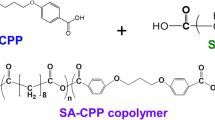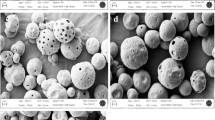Abstract
Purpose. The purpose of this study is to design microspheres for sustained protein delivery using thermosensitive, biodegradable triblock copolymer, poly (d,l-lactide-co-glycolide)-b-poly (ethylene glycol)-b-poly (d,l-lactide-co-glycolide) (PLGA-PEG-PLGA) without using organic solvent.
Methods. Microspheres of the triblock copolymer PLGA-PEG-PLGA were prepared in an aqueous-based method without using methylene chloride (Msp A). This method used the sol-gel transition property of the polymer. The size and morphology of the microspheres were examined by optical microscopy and scanning electron microscopy (SEM). Zinc crystalline recombinant human insulin was incorporated in Msp A as well as in the microspheres of the same polymer prepared by the conventional water-in-oil-in-water (w/o/w) double emulsion method using methylene chloride (Msp B). Insulin release from both microspheres was carried out using high-performance liquid chromatography (HPLC) as well as circular dichroism (CD) spectroscopy of released insulin. FITC-insulin-loaded Msp A and Msp B were observed under confocal microscopy. Both microspheres were injected subcutaneously to SD rats with diabetes induced by streptozotocin. Blood glucose and plasma insulin levels were monitored.
Results. Although the insulin release from Msp B exhibited initial burst and incomplete release, Msp A showed significant reduction of initial burst and continuous release over 3 weeks (>85%). CD spectra of released insulin showed that insulin from Msp A preserved its secondary structural integrity, whereas that from Msp B indicated changes in conformation. Confocal microscopy of FITC-insulin-loaded microspheres (both A and B) showed that the observed release profile may be attributed to homogeneous distribution of FITC-insulin within Msp A but inhomogeneiety in Msp B. Both microspheres were injected s.c. to diabetic rats. Whereas Msp B caused a burst effect (hypoglycemia) followed by quick change in blood glucose and insulin level, Msp A exhibited relatively sustained release of insulin and blood glucose level for at least 10 days.
Conclusions. The PLGA-PEG-PLGA microspheres (Msp A) demonstrated continuous release of insulin in vitro and in vivo without serious burst effect and incomplete release, as shown by Msp B.
Similar content being viewed by others
references
H. Okada. One-and three-month release injectable microspheres of the LH-RH superagonist leuprorelin acetate. Adv. Drug Deliv. Rev. 28:43-70 (1997).
S. D. Putney and P. A. Burke. Improving protein therapeutics with sustained-release formulations. Nature Biotechnol. 16:153-157 (1998).
W. Lu and T. G. Park. Protein release from poly(lactic-co-glycolic acid) microspheres: protein stability problems. PDA J. Pharm. Sci. Tech. 49:13-19 (1995).
J. L. Cleland and A. J. S. Jones. Stable formulations of recombinant human growth hormone and interferon-γ for microencapsulation in biodegradable microspheres. Pharm. Res. 13:1464-1475 (1996).
M. Morlock, T. Kissel, Y. X. Li, H. Koll, and G. Winter. Erythropoietin loaded microspheres prepared from biodegradable LPLG-PEO-LPLG triblock copolymers: protein stabilization and in-vitro release properties. J. Control. Rel. 56:105-115 (1998).
M. van de Weert, W. E. Hennink, and W. Jiskoot. Protein instability in poly(lactic-co-glycolic acid) microparticles. Pharm. Res. 17:1159-1167 (2000).
L. Meinel, O. E. Illi, J. Zapf, M. Malfanti, H. P. Merkel, and B. Gander. Stabilizing insulin-like growth factor-I in poly(D,L-lactide-co-glycolide) microspheres. J. Control. Rel. 70:193-202 (2001).
Y. M. Kwon, M. Baudys, K. Knutson, and S. W. Kim. Insulin aggregation induced by water/organic solvent interface, Pharm. Res. 18:1754-1759 (2001).
Y. H. Kim, Y. H. Bae, and S. W. Kim. pH/temperature-sensitive polymers for macromolecular drug loading and release. J. Control. Release 28:143-152 (1994).
M. Katakam, W. R. Ravis, and A. K. Banga. Controlled release of human growth hormone in rats following parenteral administration of poloxamer gels. J. Control. Rel. 49:21-26 (1997).
B. Jeong, Y. H. Bae, D. S. Lee, and S. W. Kim. Biodegradable block copolymers as injectable drug-delivery systems. Nature 388:860-862 (1997).
B. Jeong, Y. H. Bae, and S. W. Kim. Thermoreversible gelation of PEG-PLGA-PEG triblock copolymer aqueous solutions. Macromolecules 32:7064-7069 (1999).
B. Jeong, Y. H. Bae, and S. W. Kim. In situ gelation of PEG-PLGA-PEG triblock copolymer aqueous solutions and degradation thereof. J. Biomed. Mater. Res. 50:171-177 (2000).
B. Jeong, Y. H. Bae, and S. W. Kim. Biodegradable thermosensitive micelles of PEG-PLGA-PEG triblock copolymers. Colloids Surf. B: Biointerfaces 16:185-193 (1999).
B. Jeong, Y. H. Bae, and S. W. Kim. Drug release from biodegradable injectable thermosensitive hydrogel of PEG-PLGA-PEG triblock copolymers. J. Control. Rel. 63:155-163 (2000).
Y. J. Kim, S. Choi, J. J. Koh, M. H. Lee, K. S. Ko, and S. W. Kim, Controlled release of insulin from injectable biodegradable triblock copolymer. Pharm. Res. 18:548-550 (2001).
K. Hinds, J. J. Koh, L. Joss, F. Liu, M. Baudys, and S. W. Kim. Synthesis and characterization of poly ethylene glycol-insulin conjugates. Bioconjugate Chem. 11:195-201 (2000).
G. M. Zenter, R. Rathi, C. Shih, J. C. McRea, M. H. Seo, H. Oh, B. G. Rhee, J. Mestecky, Z. Moldoveanu, M. Morgan, and S. Weitman. Biodegradable block copolymers for delivery of proteins and water-insoluble drugs. J. Control. Rel. 72:203-215 (2001).
J. Brange. Galenics of Insulin. Springer-Verlag, Berlin, 1987.
J. Brange. Stability of Insulin. Kluwer Academic Publishers, Boston, 1994.
D. S. Lee, M. S. Shim, S. W. Kim, H. Lee, I. Park, and T. Chang. Novel thermoreversible gelation of biodegradable PLGA-block-PEO-block-PLGA triblock copolymers in aqueous solution. Macromol. Rapid Commun. 22:587-592 (2001).
Author information
Authors and Affiliations
Corresponding author
Rights and permissions
About this article
Cite this article
Kwon, Y.M., Kim, S.W. Biodegradable Triblock Copolymer Microspheres Based on Thermosensitive Sol-Gel Transition. Pharm Res 21, 339–343 (2004). https://doi.org/10.1023/B:PHAM.0000016248.30579.2f
Issue Date:
DOI: https://doi.org/10.1023/B:PHAM.0000016248.30579.2f




